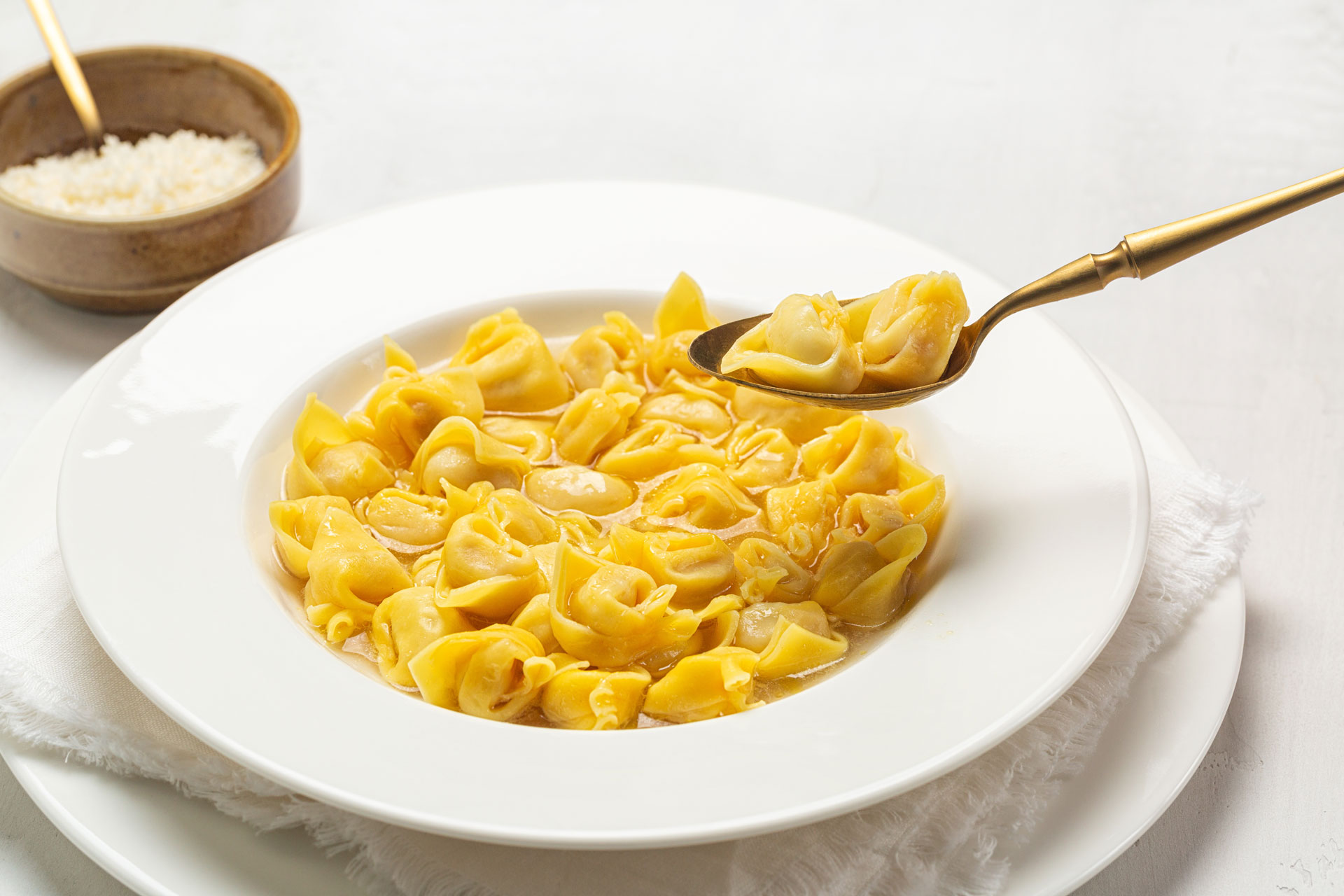Tortellini and tortelloni: a journey between taste and legend
Among the many gastronomic treasures of Emilia Romagna, tortellini and tortelloni occupy a special place, becoming symbols of a culinary tradition handed down from generation to generation. Small boxes of stuffed pasta, represent not only the taste but also the history, legends and traditions of a land that has made cooking an art. Let’s discover the differences between these two specialties, their origins and how to prepare or enjoy them.
The origins: between history and legend
The origins of tortellini and tortelloni are lost between history and mythology. One of the most fascinating legends attributes the birth of tortellini to a divine inspiration: it is said that an innkeeper from Castelfranco Emilia, after spying on the goddess Venus through the keyhole, was so impressed by the perfection of his navel that he wanted to reproduce it in the kitchen. From here would be born the famous tortellino.
From the historical point of view, tortellini have their roots in the Middle Ages, when stuffed pasta began to spread as a refined and nutritious variant. Tortelloni, on the other hand, are considered a simpler and “popular” version, often stuffed with vegetable ingredients such as ricotta and spinach, and represent the cuisine of the Emilian countryside.
Tortellini: small masterpieces of flavor
Tortellini are undoubtedly one of the undisputed symbols of Emilian cuisine, especially in the cities of Bologna and Modena. Their preparation requires great manual skill and attention to detail. The traditional filling, according to the recipe filed with the Chamber of Commerce of Bologna, consists of:
• Pork meat (loin)
• Raw ham
• Bologna mortadella
• Parmigiano Reggiano seasoned
• Nutmeg
Tortellini are usually served in capon or beef broth, a preparation that enhances the flavor of the filling and fresh pasta. However, they can also be enjoyed with cream or other light sauces, but purists prefer the broth version, symbol of tradition.
Tortelloni: the giants of stuffed pasta
Unlike tortellini, tortelloni are characterized by larger dimensions and a filling generally based on vegetarian ingredients. The most classic recipe involves a filling of:
• Fresh ricotta cheese
• Spinach (or chard)
• Parmigiano Reggiano
• Nutmeg
Tortelloni are traditionally seasoned with butter and sage, a simple combination but able to enhance the delicacy of the filling. In some variants, especially in the Emilian countryside, they can be served with tomato sauce or ragout, for a more definite taste.

The preparation of fresh pasta: art and tradition
The basis for both tortellini and tortelloni is the fresh pasta sheet, prepared with two simple ingredients: wheat flour and fresh eggs. The tradition is that the dough is spread by hand with a rolling pin, to obtain a thin and homogeneous sheet.
The manual in closing is fundamental: the tortellini are folded and rolled around the finger to create the characteristic navel shape, while the tortelloni are simply closed in the form of a crescent or triangle.
Tortellini and tortelloni in the Emilian culture
In Emilia Romagna, tortellini and tortelloni are much more than a simple dish: they are a symbol of festivity, conviviality and tradition. There is no Christmas or special occasion that does not include a warm bowl of tortellini in broth at the center of the table. Similarly, tortelloni, with their simplicity and richness of flavors, are protagonists of Sunday lunches and village festivals.
Each family has its own secret recipe, handed down from generation to generation, and the preparation of fresh pasta often becomes a moment of sharing, where grandmothers teach the new generations the secrets of tradition.
Gastronomic tourism: where to taste tortellini and tortelloni
If you want to taste the best tortellini and tortelloni, there is no better place than the cities and countryside of Emilia. Here are some tips:
• Bologna: the undisputed home of tortellini, here you will find historic restaurants and trattorias that serve tortellini in broth according to tradition.
• Modena: known for the tortellini and for pairing with Traditional Balsamic Vinegar of Modena.
• Emilian countryside: the handmade tortelloni are often found in local festivals, accompanied by butter and sage or ragu.
Many restaurants and farms also offer cooking classes to learn how to make fresh pasta, a unique experience to immerse yourself in the gastronomic culture of the Food Valley.
Conclusion: small masterpieces of tradition
Tortellini and tortelloni represent the essence of Emilian cuisine: simple in ingredients, but complex in preparation and rich in history and tradition. Each bite is a journey into the flavors of the Food Valley, a tribute to manual skill and love for good food. Whether you prefer the intense taste of tortellini in broth or the delicacy of tortelloni with butter and sage, one thing is certain: there is nothing more authentic and fulfilling than a fresh handmade pasta dish.
If you have not yet done so, let yourself be conquered by these delicacies and prepare to live an unforgettable culinary experience. Bon appetit!


